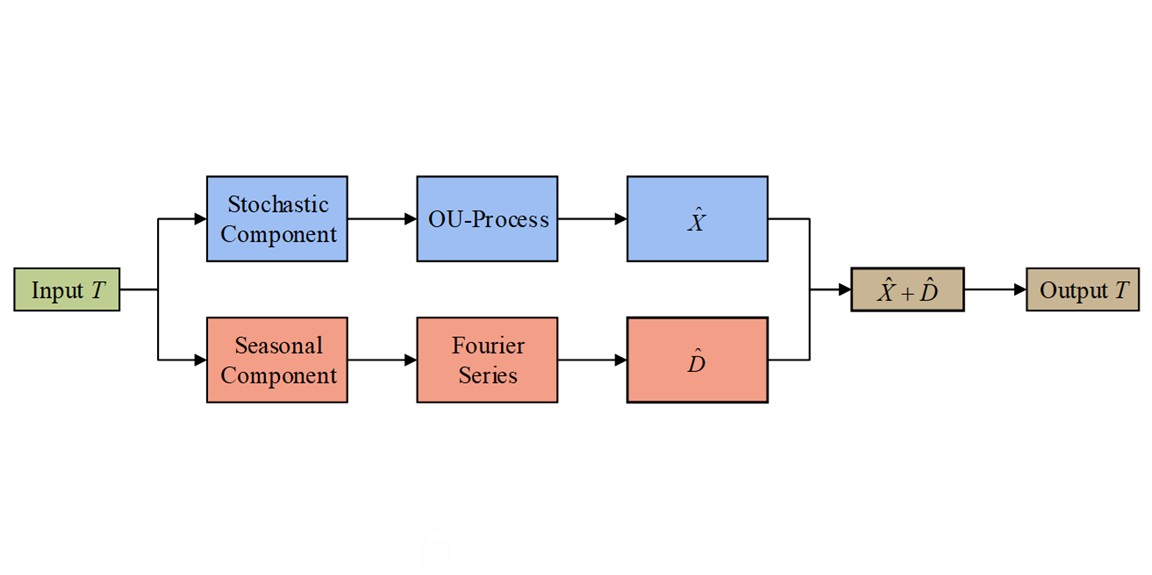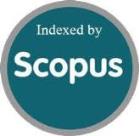Modeling the Daily Average Temperature Data Using Stochastic Process and Neural Networks for Weather Derivatives
DOI:
https://doi.org/10.46604/aiti.2024.14456Keywords:
Temperature Modelling, Ornstein-Uhlenbeck process, Elman recurrent neural network, Fourier series, hybrid modelAbstract
Weather derivatives are financial instruments influenced by temperature fluctuations, impacting industries such as agriculture, tourism, and energy. Accurate temperature modeling is essential for improving risk assessment and hedging strategies. This study evaluates the effectiveness of two forecasting hybrid approaches: the Fourier Ornstein-Uhlenbeck (OU) process, a widely used stochastic model, and the Fourier-Elman Recurrent Neural Network (ERNN), a hybrid neural network-based model. Daily temperature data from Chiang Mai, Thailand, spanning January 2005 to December 2021, were analyzed. The predictive performance of each model was assessed using root mean square error (RMSE). The results indicate the Fourier ERNN model (RMSE = 0.106) significantly outperforms the Fourier OU process (RMSE = 2.299), demonstrating superior accuracy in capturing both seasonal and stochastic variations in temperature dynamics. Thus, deep learning-based hybrid models provide a more effective framework for temperature forecasting. The proposed approach has potential applications in climate risk management, weather derivative pricing, and decision-making in climate-sensitive sectors.
References
A. Limsakul, et al., “Updated Basis Knowledge of Climate Change Summarized from the First Part of Thailand’s Second Assessment Report on Climate Change,” Applied Environmental Research, vol. 41, no. 2, pp. 1-12, 2019.
M. Kiguchi, et al., “A Review of Climate-Change Impact and Adaptation Studies for the Water Sector in Thailand,” Environmental Research Letters, vol. 16, article no. 023004, 2021.
S. Sedtha, M. Pramanik, S. Szabo, K. Wilson, and K. S. Park, “Climate Change Perception and Adaptation Strategies to Multiple Climatic Hazards: Evidence from the Northeast of Thailand,” Environmental Development, vol. 48, article no. 100906, 2023.
K. Z. Tong, A. Liu, and A. Liu, “Modeling Temperature and Pricing Weather Derivatives Based on Subordinate Ornstein-Uhlenbeck Processes,” Green Finance, vol. 2, pp. 1-19, 2020.
T. Berhane, A. Shibabaw, G. Awgichew, and A. Walelgn, “Pricing of Weather Derivatives Based on Temperature by Obtaining Market Risk Factor from Historical Data,” Modeling Earth Systems and Environment, vol. 7, pp. 871–884, 2021.
S. Prabakaran and J. P. Singh, “Modeling and Pricing of Weather Derivative Market,” Global Journal of Pure and Applied Mathematics, vol. 13, no. 12, pp. 8103–8126, 2017.
K. I. Quindala, D. C. Cuaresma, and J. Mamplata, “Modeling the Historical Temperature in the Province of Laguna Using Ornstein-Uhlenbeck Process,” European Journal of Pure and Applied Mathematics, vol. 14, pp. 327-339, 2021.
J. Wang, J. Wang, W. Fang, and H. Niu, “Financial Time Series Prediction Using Elman Recurrent Random Neural Networks,” Computational Intelligence and Neuroscience, vol. 2016, article no. 4742515, 2016.
D. Zhang, et al., “Evolving Elman Neural Networks Based State-of-Health Estimation for Satellite Lithium-Ion Batteries,” Journal of Energy Storage, vol. 59, article no. 106571, 2023.
M. D. Eggen, K. R. Dahl, S. P. Näsholm, and S. Mæland, “Stochastic Modeling of Stratospheric Temperature,” Mathematical Geosciences, vol. 54, pp. 651-678, 2022.
M. Darus and C. Taib, “Modelling Temperature Using CARMA Processes with Stochastic Speed of Mean Reversion for Temperature Insurance Pricing,” Malaysian Journal of Mathematical Sciences, vol. 16, no. 2, pp. 273-288, 2022.
A. Giorgini, R. S. Mamon, and M. R. Rodrigo, “A Stochastic Harmonic Oscillator Temperature Model for the Valuation of Weather Derivatives,” Mathematics, vol. 9, no. 22, article no. 2890, 2021.
B. Žmuk and M. Kovač, “Ornstein-Uhlenbeck Process and GARCH Model for Temperature Forecasting in Weather Derivatives Valuation,” Croatian Review of Economic, Business and Social Statistics, vol. 6, no. 1, pp. 27-42, 2020.
A. Alfonsi and N. Vadillo, “A Stochastic Volatility Model for the Valuation of Temperature Derivatives,” IMA Journal of Management Mathematics, vol. 35, no. 4, pp. 737–785, 2024.
M. S. Khan, J. Ivoke, M. Nobahar, and F. Amini, “Artificial Neural Network (ANN) Based Soil Temperature Model of Highly Plastic Clay,” Geomechanics and Geoengineering, vol. 17, no. 4, pp. 1230-1246, 2021.
P. Anushka, A. H. MD, and R. UPAKA, “Comparison of Different Artificial Neural Network (ANN) Training Algorithms to Predict the Atmospheric Temperature in Tabuk, Saudi Arabia,” Mausam, vol. 71, no. 2, pp. 233-244, 2020.
R. A. Kazeem, J. U. Amakor, O. M. Ikumapayi, S. A. Afolalu, and W. A. Oke, “Modelling the Effect of Temperature on Power Generation at a Nigerian Agricultural Institute,” Mathematical Modelling of Engineering Problems, vol. 9, no. 3, pp. 645-654, 2022.
P. Joshi and A. Ganju, “Maximum and Minimum Temperature Prediction over Western Himalaya Using Artificial Neural Network,” Mausam, vol. 63, no. 2, pp. 283-290, 2012.
G. Araujo and F. A. Andrade, “Post-Processing Air Temperature Weather Forecast Using Artificial Neural Networks with Measurements from Meteorological Stations,” Applied Sciences, vol. 12, no. 14, article no. 7131, 2022.
M. Bilgili, A. Ozbek, A. Yildirim, and E. Simsek, “Artificial Neural Network Approach for Monthly Air Temperature Estimations and Maps,” Journal of Atmospheric and Solar-Terrestrial Physics, vol. 242, article no. 106000, 2023.
E. A. Nketiah, L. Chenlong, J. Yingchuan, and S. A. Aram, “Recurrent Neural Network Modeling of Multivariate Time Series and Its Application in Temperature Forecasting,” PLoS ONE, vol. 18, no. 5, article no. e0285713, 2023.
X. Dai, J. Liu, and Y. Li, “A Recurrent Neural Network Using Historical Data to Predict Time Series Indoor PM2.5 Concentrations for Residential Buildings,” Indoor Air, vol. 31, no. 3, pp. 1228-1237, 2021.
S. A. Gyamerah and V. Owusu, “Short- and Long-Term Weather Prediction Based on a Hybrid of CEEMDAN, LMD, and ANN,” PLoS ONE, vol. 19, no. 7, article no. e0304754, 2024.
U. Leith, “Modeling a Periodic Signal Using Fourier Series,” Journal of Applied Mathematics and Physics, vol. 12, pp. 841-860, 2024.
E. Ekpenyong and C. Omekara, “Application of Fourier Series Analysis to Temperature Data,” Global Journal of Mathematical Sciences, vol. 7, no. 1, pp. 5-13, 2008.
Q. Wang, J. Feng, F. Han, W. Wu, and S. Gao, “Analysis and Prediction of Grain Temperature from Air Temperature to Ensure the Safety of Grain Storage,” International Journal of Food Properties, vol. 23, no. 1, pp. 1200-1213, 2020.
Y. Zong‐chang, “Fourier Analysis‐Based Air Temperature Movement Analysis and Forecast,” IET Signal Processing, vol. 7, no. 1, pp. 14-24, 2013.
C. Y. Tang and S. X. Chen, “Parameter Estimation and Bias Correction for Diffusion Processes,” Journal of Econometrics, vol. 149, no. 1, pp. 65-81, 2009.
T. Guillod, P. Papamanolis, and J. W. Kolar, “Artificial Neural Network (ANN) Based Fast and Accurate Inductor Modeling and Design,” IEEE Open Journal of Power Electronics, vol. 1, pp. 284-299, 2020.
M. A. Rubi, S. Chowdhury, A. A. A. Rahman, A. Meero, N. M. Zayed, and K. A. Islam, “Fitting Multi-Layer Feed Forward Neural Network and Autoregressive Integrated Moving Average for Dhaka Stock Exchange Price Predicting,” Emerging Science Journal, vol. 6, no. 5, pp. 1046-1061, 2022.

Published
How to Cite
Issue
Section
License
Copyright (c) 2025 Kanyarat Thitiwatthanakan, Manad Khamkong, Ravi Lonkani, Thanasak Mouktonglang

This work is licensed under a Creative Commons Attribution-NonCommercial 4.0 International License.
Submission of a manuscript implies: that the work described has not been published before that it is not under consideration for publication elsewhere; that if and when the manuscript is accepted for publication. Authors can retain copyright in their articles with no restrictions. is accepted for publication. Authors can retain copyright of their article with no restrictions.
Since Jan. 01, 2019, AITI will publish new articles with Creative Commons Attribution Non-Commercial License, under The Creative Commons Attribution Non-Commercial 4.0 International (CC BY-NC 4.0) License.
The Creative Commons Attribution Non-Commercial (CC-BY-NC) License permits use, distribution and reproduction in any medium, provided the original work is properly cited and is not used for commercial purposes.







